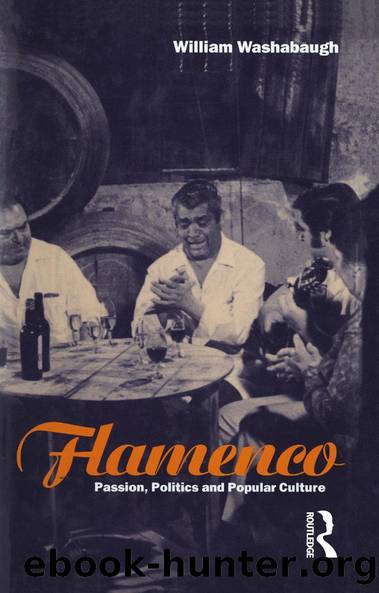Flamenco by William Washabaugh

Author:William Washabaugh [Washabaugh, William]
Language: eng
Format: epub
Tags: Social Science, Anthropology, Cultural & Social
ISBN: 9781317134862
Google: gH0GDAAAQBAJ
Barnesnoble:
Publisher: Routledge
Published: 2016-04-15T03:13:02+00:00
Cante and the Body
The remainder of this chapter will argue that flamenco bodies hint at processes other than those described as communal or competitive. Specifically, we need to open up a larger role for both muscle memory and bodily pain in the process of song. Our discussion will focus first on music and memory and then move to the issue of music and pain.
Program no. 40 (see Chapter 9) in the âRitoâ series opens with a scene that illustrates something of the connection between body and memory in flamenco song. The scene was shot in a simple and bare tavern in La Cabeza de San Juan, Cádiz, where seven men are gathered, for drinking, smoking, and singing. A man, with a guitar resting upside down on his thighs, taps out a rhythm of bulerÃas that the group turns and twists and elaborates into a symphony of percussive sounds with song and dance. The demeanor of the group throughout the nearly four minutes of performance is relaxed and unconcentratedâ¦almost off-handed. Their lack of concentration suggests that their rhythmic competence is managed less by their minds or hearts or spirits than by their nerves and muscles. This rhythmic competence is neither genetically programmed, as suggested by Molina (1985: 63ff.), nor culturally distinctive, as suggested by Mairena (1976: 79). Rather, it is the product of years of repetition. In the simplest terms, the rhythmic competence displayed in program no. 40 is a matter of habit.
As a habit, rhythmic competence might be passed off as peripheral and incidental. It is neither. An increasing amount of evidence suggests that the control of complex musical rhythm is central to human activity (see Calvin 1990: 194; Chanan 1994: 85f.). Moreover, the musical rhythms that are handled by the ear probably involve other senses, the visual, the olfactory, etc. since âthe memory of one sense is stored in another: that of tactility in sound, of hearing in taste, of sight in soundâ (Serematakis 1994: 216). Rather than being narrow and peripheral, the rhythmic abilities displayed in this program are of broad and central importance.
A significant feature of these abilities is that they are social rather than individual. The habitual control of flamenco rhythms is collaborative; it is a moment of social coordination. Such rhythmic collaboration illustrates another side of what Connerton has called âritesâ, that is, events of âsocial memoryâ through which people establish âcontinuity with the pastâ (see Connerton 1989: 44f.).
Connertonâs term ârite,â like term rito in the title of the documentary film series, refers to events that link the present to the past. However, now it should be becoming clear that the links that song establishes are forged by bodies as much as by minds. Habitual control of collaborative rhythms is a transtemporal physical ability that operates more powerfully and effectively than ordinary words. For one thing, such rhythmic abilities are phylogenetically more profound than speech insofar as they are widely shared by non-humans (Donald 1991: 175). For another, these rhythmic abilities are socially profound in the sense that they emanate from what Bakhtin would call âthe lower bodily stratum.
Download
This site does not store any files on its server. We only index and link to content provided by other sites. Please contact the content providers to delete copyright contents if any and email us, we'll remove relevant links or contents immediately.
The Goal (Off-Campus #4) by Elle Kennedy(13368)
Kathy Andrews Collection by Kathy Andrews(11677)
Diary of a Player by Brad Paisley(7416)
What Does This Button Do? by Bruce Dickinson(6100)
Assassin’s Fate by Robin Hobb(6055)
Big Little Lies by Liane Moriarty(5648)
Altered Sensations by David Pantalony(5003)
Pale Blue Dot by Carl Sagan(4856)
Sticky Fingers by Joe Hagan(4064)
The Death of the Heart by Elizabeth Bowen(3483)
The Heroin Diaries by Nikki Sixx(3448)
Beneath These Shadows by Meghan March(3225)
Confessions of a Video Vixen by Karrine Steffans(3205)
How Music Works by David Byrne(3078)
The Help by Kathryn Stockett(3043)
Jam by Jam (epub)(2983)
Harry Potter 4 - Harry Potter and The Goblet of Fire by J.K.Rowling(2942)
Strange Fascination: David Bowie: The Definitive Story by David Buckley(2760)
Petty: The Biography by Warren Zanes(2637)
